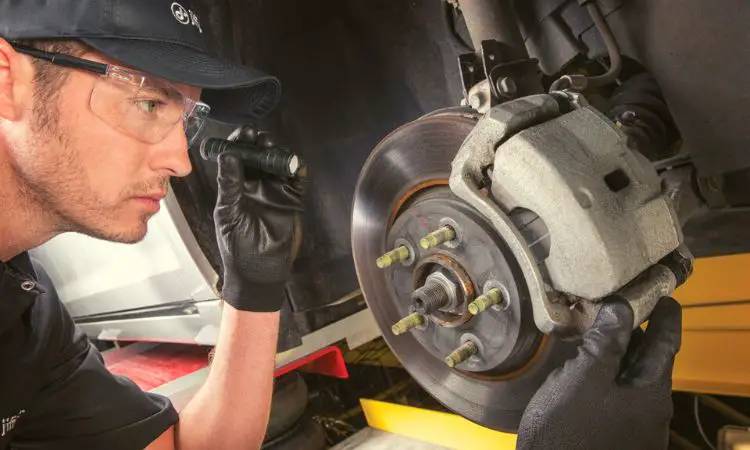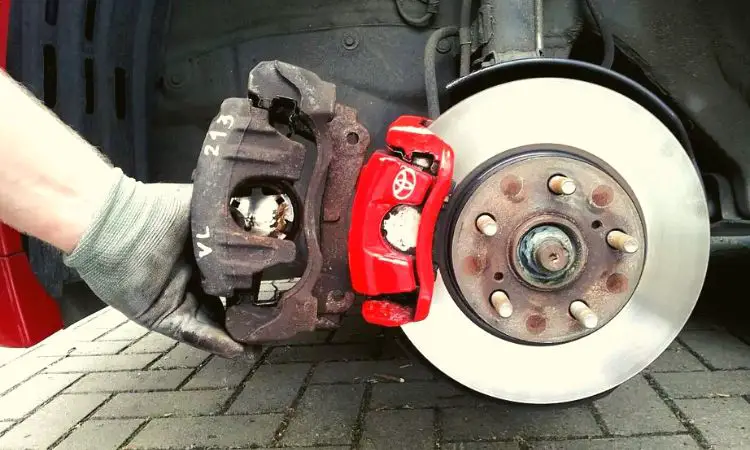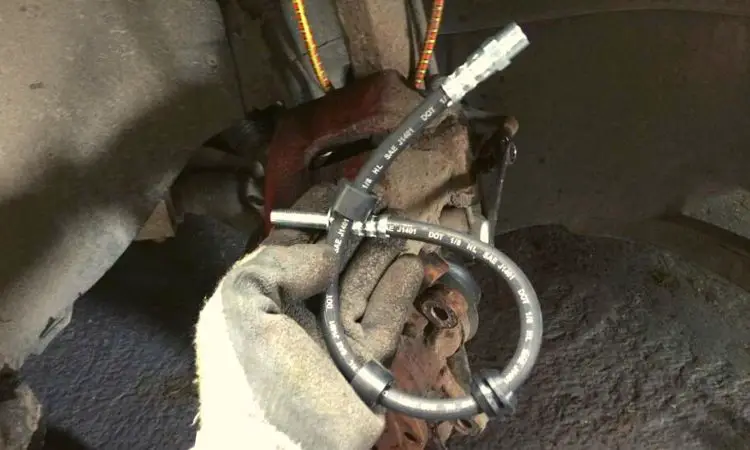Hey there! This post contains affiliate links to products. We may receive a commission for purchases made through these links. But it never influences our product selection process.
Brakes are the unsung heroes of your car, responsible for keeping you safe on the road. But what happens when your brakes can’t build pressure when bleeding them?
Check for air in the brake line; if air is present, remove it. Then check for a faulty master cylinder or brake caliper and repair or replace it as needed. Finally, check for blocked brake lines and replace or clean brake lines.
Solving brake pressure build issues can be a daunting task. But I will teach you an easy troubleshooting guide for can’t build pressure when bleeding brakes. Let’s explore.
Common mistakes when bleeding brakes
Bleeding brakes are an essential maintenance task that helps ensure the safety of you and your vehicle. But due to some common mistakes, people face problems in building pressure when bleeding brakes.
Using Improper Tools:
People do not pay much attention to tools and materials and ultimately experience bleeding issues. The wrong size wrench, the wrong type of bleeder valve, or low-quality brake fluid.
Not Following The Proper Sequence:
Another common mistake is not following the proper sequence while bleeding the brakes. Each car manufacturer has a specific sequence for bleeding the brakes that need to be followed. If you do not follow the sequence, you may experience a bleeding brake issue.
Low Brake Fluid:
Carelessness about the brake fluid level is a common mistake.
Low brake fluid levels can introduce air into the brake system. It may cause a spongy brake pedal and decreased braking power.
Not Checking For Leaks:
Many car owners fail to check for leaks while bleeding the brakes. It can lead to a loss of brake fluid and compromised braking performance.
Over-Tightening The Bleeder Valve:
The Bleeder valve should be tight but not over. An over-tighten bleeder valve makes it tough to bleed. After a few days, you may start experiencing improper bleeding brake issues.
Can’t Build Pressure When Bleeding Brakes [Troubleshooting Guide]

When it comes to troubleshooting the pressure-building issue when bleeding brakes, knowing the causes first is essential. Once you know the cause, solving the problem will be a lot simpler.
What Are The Causes of Can’t Build Pressure When Bleeding Brakes?
There are several possible causes for not being able to build pressure when bleeding brakes. Here is the list of common causes when you fail to build pressure when bleeding brakes.
- Air in the brake lines
- Faulty brake master cylinder
- Brake caliper problem
- Blocked brake lines
Can’t Build Pressure When Bleeding Brakes [ Problems & Solution Guide]
Following are some possible problems and solutions related to bleeding brakes.
Problem 1: Air in The Brake Lines
Air in the brake lines creates a vacuum inside the lines; ultimately, you may can’t get brakes to build pressure. It is necessary to remove air to ensure a consistent supply of brake fluid.
Solution:
- Start by filling the brake master cylinder with brake fluid.
- Then locate the brake bleed valve on the brake caliper or wheel cylinder.
- Next, attach a clear plastic hose to the bleed valve and put the other end of the hose into a container with brake fluid.
- Open the bleed valve with a wrench and press the brake pedal slowly.
- Close the valve before the pedal reaches the floor.
- Repeat the same process until you see no bubbles in the hose
Problem 2: Faulty Brake Master Cylinder

A faulty master cylinder can be the culprit for pressure-building problems when bleeding brakes. For consistent pressure building, you will need to replace the master cylinder.
You may also experience trailer brake controller problems in Dodge Ram and Ford Integrated trailers due to faulty master cylinders.
Solution:
- First, park your vehicle on a level surface
- Loosen the lug nuts on the wheels
- Remove the wheels and the brake calipers
- Detach the brake lines from the master cylinder and remove them.
- Install the new master cylinder. You may find the Dorman M630031 Brake Master Cylinder as the best choice for your vehicle. It is an excellent performer and compatible with multiple vehicles.
- Once installed, the new master cylinder attaches to the brake lines.
- Fill the master cylinder with brake fluid and bleed the brakes
- Repeat the bleeding process for each wheel. Ensure no air bubbles in the hose.
- Reattach the brake calipers and wheels and test the brakes to ensure proper pressure.
Problem 3: Brake Caliper Problem

A faulty brake caliper is also a common cause of pressure issues while bleeding brakes. You need to replace the caliper to resolve the problem.
Solution:
- Raise the vehicle and remove the wheel.
- Locate the faulty caliper and remove the brake line and bolts holding the caliper in place.
- Take out the old caliper and install the new one. I recommend ACDelco Gold 18FR1379 Disc Brake Caliper. It is durable and easy to replace.
- Once replaced, reconnect the brake line and bolts.
- Now, bleed the brake system to remove air bubbles.
- Reinstall the wheel and lower the vehicle.
- Test the brakes to ensure proper functioning.
Read here if you are facing both front brake calipers not releasing.
Problem 4: Blocked Brake Lines

If the brake lines are dirty or you use low-quality brake fluid, it may block them. Blocked brake lines fail to ensure consistent brake fluid supply for proper functioning. You will need to clean or replace the blocked brake lines.
Solution:
- Park your vehicle on a level surface
- Locate the brake lines
- Check for the blockage of brake lines
- If brake lines are blocked, try to clean the brake lines using brake line cleaner. CRC BRAKLEEN Brake Parts Cleaner is an excellent cleaner for cleaning brake lines.
- If the brake lines are too dirty, replace them brake lines
- Reinstall the brake lines and test the brake functioning
Read this before cleaning the brake lines: Brake cleaner as starting fluid diesel
Tips to Prevent Can’t Build Pressure When Bleeding Brakes Problem
- Always use fresh brake fluid and ensure that the fluid reservoir is filled to the correct level.
- Use a high-quality brake bleeding kit that is specifically designed for your vehicle.
- Bleed the brakes in the correct order
- Make sure that there are no leaks in the brake lines or connections.
- Keep brake calipers and pads in good condition
How Much Pressure to Bleed Brakes?
The pressure required to bleed brakes depends on the specific brake system and the type of brake bleeder used. Typically, a 20-30 psi pressure is sufficient for most systems. However, consulting the vehicle’s manual or a professional mechanic for specific recommendations is best.
How to Power Bleed Brakes?
Powering bleed brakes is an easy process. Follow the steps below to power the bleed brakes on your vehicle.
- Fill the pressure bleeder with fresh brake fluid.
- Connect the bleeder to the brake fluid reservoir.
- Open the bleeder valve on the caliper furthest from the reservoir.
- Turn on the pressure bleeder and allow fluid to flow until no air bubbles are present.
- Repeat steps 3-4 for each caliper
How to Pressure Bleed Abs Brakes?
- Fill the master cylinder with the recommended brake fluid.
- Connect a pressure bleeder to the brake system’s reservoir.
- Pump the pressure bleeder up to the recommended pressure.
- Starting with the wheel furthest from the master cylinder, open the bleeder valve until brake fluid flows out.
- Close the bleeder valve and move on to the next wheel.
- Once all wheels have been bled, top off the brake fluid in the master cylinder and remove the pressure bleeder.
How to Pressure Bleed Aircraft Brakes?
- Remove the reservoir cap and fill it with the recommended brake fluid.
- Connect the pressure bleeder to the brake system.
- Apply pressure to the bleeder and open the bleeder screw.
- Repeat the process until all air bubbles are eliminated.
- Refill the reservoir to the proper level and secure the cap.
How to Bleed Power Brake Booster?
- Park the vehicle on a flat surface and turn off the engine.
- Remove the brake fluid from the reservoir until it is below maximum.
- Locate the brake booster and remove the vacuum hose attached to it.
- Then press the brake pedal multiple times until it becomes hard.
- Reconnect the vacuum hose and refill the brake fluid.
- Start the engine and test the brake pedal for proper operation.
Frequently Asked Questions (FAQs):
Why won’t my ATV brakes build pressure?
Why won’t my brakes hold pressure?
01. Leak in the brake lines
02. Worn brake pads or rotors
03. Malfunctioning master cylinder
04. Problem with the brake booster
How can I firm up my brake pedal?
01. Bleeding to remove air bubbles from the brake lines
02. Replacing worn brake pads or shoes
03. Adjusting the brake pedal height
04. Pressing Brake pads for multiple times
Is it safe to drive with low-pressure brakes?
Conclusion
Bleeding brakes are an essential maintenance task for ensuring safe driving. But common mistakes can lead to problems in building pressure. By identifying the cause, you can easily troubleshoot the problem. However, never try this if you are not confident in your skills.

